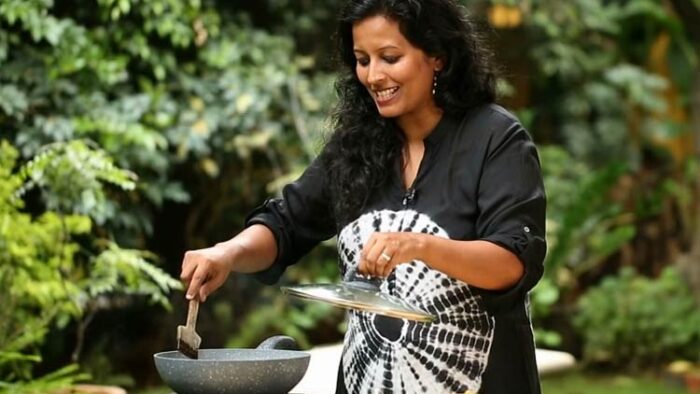Indian thali comes with histories of India’s places, and people telling you who they are and why they eat what they eat – Dr Nandita Iyer, doctor, blogger and author of The Great Indian Thali – Seasonal Vegetarian Wholesomeness
For this trained doctor and nutrition specialist, cooking has been a passion and writing, a hobby. Dr Nandita Iyer has been blogging for many years before she began to write books that bring together everyday nutrition and healthy eating. Her blogs, articles and books come loaded with exciting vegetarian recipes and whole lot of practical advice thrown in. Her latest book - The Great Indian Thali – Seasonal Vegetarian Wholesomeness – explores Indian landscape, the quintessentially local thalis that are mouthwatering made using local produce – the vegetables, fruits, nuts, grains and cereals. The food we eat is reflective of the climate, the landscape, traditions and in Dr Nandita’s words it comes with histories of India’s places, and people telling you who they are and why they eat what they eat.
 About the book – ‘The Great Indian Thali…’ she shares, “The book is divided into seasons, colour coded for Spring, Summer, Monsoon and Winter. It brings vegetarian recipes from different parts of India keeping in view what is seasonal, the festivals, what dishes can be made using local produce. It has recipes of vegetarian dishes, snacks, rice recipes – a little bit of everything – in short - it is a sneak peek into what is India eating in terms of vegetarian food across seasons. It is decorated with flowers from each season and takes you through the sensory experience of Monsoons in Mumbai, winters in Kashmir and summers in the north. The book also has a playlist of Hindustani music with QR Code. It is a playlist of music for every season that you can play while cooking or entertaining to create the mood.”
About the book – ‘The Great Indian Thali…’ she shares, “The book is divided into seasons, colour coded for Spring, Summer, Monsoon and Winter. It brings vegetarian recipes from different parts of India keeping in view what is seasonal, the festivals, what dishes can be made using local produce. It has recipes of vegetarian dishes, snacks, rice recipes – a little bit of everything – in short - it is a sneak peek into what is India eating in terms of vegetarian food across seasons. It is decorated with flowers from each season and takes you through the sensory experience of Monsoons in Mumbai, winters in Kashmir and summers in the north. The book also has a playlist of Hindustani music with QR Code. It is a playlist of music for every season that you can play while cooking or entertaining to create the mood.”
Book is not about giving out recipes for full thalis. It has got different dishes from appetisers, to main course, and desserts, which you can put together to make a thali. There are also a bunch of basic recipes like dal, rice, rotis parathas, she adds.
Excerpts from the interview:
What is your definition of a good nutritious thali?
Healthy thali versus unhealthy – it’s all about balance. These days on social media people want to post pictures of thalis with tons of dishes. It looks good and plentiful, but it is not necessarily balanced and it’s a lot of food. It has a negative impact on portion control and good balance of carbohydrates, proteins, a variety of vegetables is usually missing as these thalis come overloaded with crabs, lot of processed food – refried in refined oil, and sugars.
A good thali is simple, moderate and delicately done. Anything in the name of Indian and traditional is not right – it should be in the context of right time and right proportion. I do not subscribe to these marketing trends like these huge freak shakes that come with 2000 calories and a whole lot of sugar, colours and additives, and spin on traditional in the name of fusion.
Once in a while it is okay to eat these Bahubali thalis but like tobacco comes with a warning that it is injurious to health, these thalis must come with a warning.
 Why a dedicated book for thalis, and what can the reader expect?
Why a dedicated book for thalis, and what can the reader expect?
There are tons and tons of books on Indian vegetarian food and recipes. What I like about my book is that it is about the seasonal recipes, from east, west north and south. The dishes can be paired with other dishes from the same region or other regions to make a really balanced colourful, light meal. In India, and around the world, we have vegetables available round the year now. We have winter vegetables like cauliflower, peas that are available in summers, and gourds and bhendi during winters. But the fact remains that the vegetables are at the most nutrition and flavoursome best when they are in season. Try making a winter vegetable pickle and it will be a level beyond what it tastes when you make it in summer. Experiencing the taste of fresh vegetables growing seasonally and not from cold storage is the key for getting nutrition needed for the season. For example, eating amla or turmeric during winters gives extra anti-oxidants and vitamin c, which you need in building immunity for the season. And, it is about eating little bit every day, and not just one day. The whole point of the book is focus on India, focus on vegetarian mostly plant based and eating seasonal and local.
Can you share about any unique thalis you would have tasted?
One of the unique thalis I tasted was Manipuri. My friend and neigbour made this beautiful vegetarian thali, which I was not aware at the time that it is very prominent in Manipur. Apparently, devotees of Lord Krishna offer it as prashad. They don’t use metallic cups. Each of cups for each dish is made using banana leaves. It is colourful and stunning visually. It is a balanced meal served with a lot of local greens and flavouring and unique dishes, it was a joy to try it out at her place.
In recent times people seem to be going back to their roots in terms of food. What is your view?
It’s always nice that people are rediscovering their roots, and the cuisines of their ancestors, and discovering what’s local beyond four – five vegetables we use. It’s important to go beyond, towards the bio diverse diet- otherwise we will end up losing local varieties of vegetables, millets…If no body eats, they will stop growing and we will be left with a very little choice. I think it’s important to discover old recipes with an eye on what modern science of what suits our current lifestyle - if are you a sedentary person, are you active and what suits your fitness goals and health condition.
What is the most important element of an Indian thali?
There’s nothing called important dishes on Indian thali. Everything has its place and importance. Its either contributing towards flavour or texture or its adding freshness or aiding digestion.
What is that one unique feature in all Indian thalis?
The concept of Indian food is that we don’t eat course wise. And, even if we begin with rice and dal, or roti, we take everything on the plate. We eat each bite as per out preference or liking. I can take rice and curry with some chutney and that makes a morsel, sometimes a bit of roti with sabji dipped in dal or rice with dahi and pickle – that makes a morsel. Infinite permutations and combination of eating bites as per your own liking and what your heart desires while you are eating the food – that is the beauty of Indian thali.





